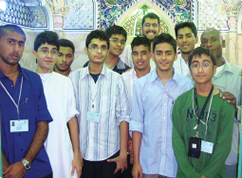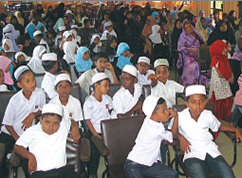We are now pleased to present this collection of inspirational anecdotes and insights into the lives of the recent and contemporary scholars, narrated in the voice of the author himself. You can hear Shaykh relate stories that he has personally researched and been touched by to form a better, deeper understanding of how our scholars apply Islamic principles in their daily lives.
Imam Ali (as)
|
Name |
Ali bin Abu Talib (as) |
|
Title |
Ameerul Mu’mineen |
|
Kunya |
Abul Hasan |
|
Date of Birth |
13 Rajab 600AD |
|
Place of Birth |
Makkah |
|
Father |
Abu Talib bin Abdul Muttalib |
|
Mother |
Fatema binte Asad |
|
Date of Death |
21 Ramadan 40AH |
|
Place of Death |
Kufa |
Imam Ali (as) was the first of the twelve Imams and the youngest of the four sons of Abu Talib and Fatema binte Asad. He was the first cousin of the Holy Prophet (saw) through the brotherhood of their fathers. Imam Ali (as) was adopted and raised by the Holy Prophet (saw), remaining his closest friend and was appointed his deputy and successor.
After his unique birth in the Kaaba, he was adopted and raised by the Holy Prophet (saw), following and learning from him everywhere they went, including up to the Mount of Hira for meditation. Imam Ali (as) was the first to accept and adhere to the Prophethood of Prophet Muhammad (saw) privately and was unique in his allegiance to propagating and being the deputy of the Prophet (saw) at Dawatul Ashira 3 years later. He remained as the protector of the Holy Prophet (saw) in front of the enemies of Islam. When the hostility grew, the Prophet initiated the Hijra to Mecca as the Meccans plotted an assassination plot. Imam Ali (as) slept in the bed of the Holy Prophet (saw) in order to protect the life of the Holy Prophet (saw), before being entrusted to bring the ladies of the family to Medina.
The Holy Prophet created a bond of brotherhood between the Muslims, making Imam Ali (as) his Muslim brother saying “O Ali, you are my brother in this world as well as in the next.” Once the migrant Muslims settled in the newly adopted city of Madina, their first task was to complete the building of the mosque around which their houses were also built. Imam Ali (as) initially stayed with his mother but when he married Bibi Fatima (as), the daughter of the Prophet, he was given a house next to the Prophet by the side of the mosque. Materially the couple did not possess much, but spiritually they were at the highest level of assent. They had no worries if they went hungry or their clothes had patches. They would be more concerned if an orphan went away from their door without receiving any food.
Despite his soft heartedness in society, Imam Ali (as) was the most fearsome of warriors on the battlefield. The battles of Badr, Ohud, Khandaq and Khyber were fought in the defence of Islam and won by the hands of Imam Ali (as). He was not only the standard bearer of the flag of Islam in these battles, but always led the forces of Islam and came out victorious. Khyber was the climax of these battles when his famous victory brought prosperity in the Muslim ranks.
An example of his pure intentions was in the Battle of Khandaq, when the Muslims dug a ditch around themselves for their defence, so that the enemy could not get across. A man from the enemy side called Amr bin Abdawud, who was known for his strength, courage and art of fighting, managed to get across the ditch. All the Muslims were terrified of fighting him and only Imam Ali (as) came forward to fight this man. Just as Imam Ali (as) was about to kill this enemy of Islam, he spat on the face of Imam Ali (as). He moved from Amr bin Abdawud's chest and walked away. Amr bin Abdawud attacked Imam Ali (as) again and after a short while, he again overpowered Amr bin Abdawud and killed him. Afterwards, Imam Ali (as) replied that if he had killed him then it would have not been only for the sake of Allah (SWT) but also for the satisfaction of his anger and so he let him free. Imam Ali (as) controlled his anger and killed Amr bin Abdawud purely for the sake of Allah.
The peace agreement of Hudaibiya was written by Imam Ali (as) and at the time of the peaceful victory at Makkah, the idols of the Kaaba were demolished by the Holy Prophet (saw) with the help of Imam Ali (as). The battle of Hunayn, against various tribes from outside the city who rose against Islam, saw Imam Ali (as) lead an army of only 7 to defeat the enemy as the rest of the army deserted the Holy Prophet (saw).
For the next ten years, Imam Ali (as) was the deputy to the Holy Prophet (saw) and gained numerous accolades, including during the events of Hadith al Kisa and Mubahila. The final declaration of his succession to the Holy Prophet (saw) was made at Ghadeer Khum, where over 100,000 Muslims paid allegiance to him after the Holy Prophet (saw) said, ““Hear and remember that to whomever I am Lord or Mawla, Imam Ali (as) is the Lord and Maula to him. He is to me what Aaron was to Musa.”
However, despite this open declaration, whilst Imam Ali (as) buried the Holy Prophet (saw), a small group of the Holy Prophet’s (saw) companions, including the first two caliphs, chose the next leader of the Ummah from amongst themselves at Saqeefa, excluding Imam Ali (as). Over the next 23 years, across the period of the first three caliphs, he remained patient and remained on hand to provide advice, despite the injustices against him. He explained his silence and showed the level of his patience in a letter to Malik al Ashtar, saying “.. And I withheld my hand until I found the deserters of the faith of Islam calling for the destruction of the religion of Muhammad. As this danger emerged I reversed my position and decided to aid Islam and its followers lest I witness a total or partial destruction in Islam then the tragedy to me becomes greater than losing your leadership which is only transitory."
After the death of Uthman, the third Caliph, Imam Ali (as) was elected by the Muslims to take over the leadership. As he set about trying to re-establish the society built by the Holy Prophet (saw), he faced many challenges as many had returned to the feudal, greedy ways of the period of Jahiliyya before Islam. He faced enemies such as Muawiyah and the Khawarij, fighting the battles of Siffeen, Nahrawan and Jamal. However, despite the attempts made to undermine Imam Ali’s (as) Caliphate, it is regarded by historians as the best period after the death of the Holy Prophet (saw).
On the 19th of Ramadhan 40 AH, Ibn Muljam al-Muradi, struck him at the mosque of Kufa, which he had come out to in order to wake the people for the dawn prayer on the night of the nineteenth of the month of Ramadan. He had been lying in wait for him from the beginning of the night. He struck the forehead of the Imam (as) whilst he was in sujood of the Nafila prayers of Fajr. Such was the mercy and patience that defined the life of Imam Ali (as), that when they captured Ibn Muljam, he first ordered that the ropes on his hands be loosened and that he should only be struck with one blow to match the one he struck on Imam Ali (as).
The death of Imam Ali (as) took place before dawn of Friday, the twenty-first of the month of Ramadan, in the year 40 A.H. His two sons, Imam Hasan (as) and Imam Husain (as), performed the tasks of washing him and shrouding him. Then they carried him to al-Ghari at Najaf and they buried him there. They removed the traces of the place of his burial according to his bequest as he knew about the regime of the Umayyads which would come after him, and their hostile attitude towards him, as well as the hatred of the Khawarij. Only during the time of Imam Sadiq (as), the sixth Imam, was the location of the grave revealed.
Sources:
- Kitab al Irshad - Pages 1 – 6, The Book Of Guidance, By Shaykh al Mufid
- Story of the Holy Ka’aba and its People, SMR Shabbar, Muhammadi Trust of Great Britain and Northern Ireland, 1997
- The Brother of the Prophet Muhammad: Imam ‘Ali, Shaykh Muhammad Jawad Chirri, The Islamic Center of America
Related News
Learn about all the incredible training which took place between MCE and Madaris teachers this month!
7th November 2020
Updated 11 December 2013
The World Federation has recently sponsored the publication of the book “Goals of Hussain (as)’s Uprising” into Burmese, as part of its efforts in External Tableegh.
The original was written by Ayatullah Nasir Makarim Shirazi, and was translated into Burmese by a student of Hawza Ilmiyya Qum, Shaykh Jamaal Hussain from Myanmar.









